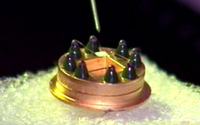'Artificial nose' detects dangerous gases in the air
Chemists from the Moscow State University invented a device which possesses the properties of the dog's sense of smell. The device, dubbed as ‘Foxilab’ is capable of detecting the presence of dangerous gases in the air. The scientists used nanotechnologies in their work and became the first in the field.

The scientists call this device “the artificial nose”. Nanotechnologies allowed to create sensors which could sense even smallest amounts of dangerous gases in the air. The researchers from the Moscow State University continue running lab tests of their invention. Scientific corporations are now preparing for the mass production of devices based on this technology.
“First of all, the device allows us to find out the presence of dangerous substances in the air. Secondly, it gives information about the concentration of these substances", Valery Krivetsky, the post-graduate student of the chemical laboratory of the Moscow State University said.
Russian scientists have outstripped their foreign colleagues in this field. Their device differs from other gas analyzers greatly. It is much more sensitive and it reacts even to slightest changes in the air structure. Moreover, this device easily distinguishes one gas from another.
"We use special nanoparticles which have nanoreceptors on their surface. These nanoreceptors define groups of gases and separate them from others. The receptors can be applied in different fields of science", Alexander Gaskov, the professor of the Chemistry Department of the Moscow State University explains.
Although “the artificial nose” can be found only in laboratories, some devices based on this technology are already used in everyday life. They can be installed at airports, underground stations and in the streets. If dangerous gas concentration reaches a high level, the device will inform immediately about the danger.
The scientists from the Moscow State University have laid down rather ambitious goals for themselves. They are going to reduce this device to the size of a SIM card for cell phones.
"Now we want to create the tiny version of this device which could be inserted into a cell phone to inform a person about the concentration of dangerous gases. The device could, for example, inform its user about the increase of carbonic dioxide concentration when he or she gets stuck in a traffic jam", Marina Rumyantseva, a senior lecturer in chemistry of the Moscow State University said.
Vesti-Moscow.Ru
Subscribe to Pravda.Ru Telegram channel, Facebook, RSS!


